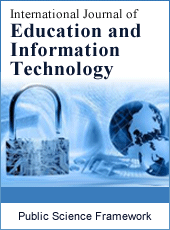International Journal of Education and Information Technology
Articles Information
International Journal of Education and Information Technology, Vol.1, No.5, Dec. 2015, Pub. Date: Jan. 6, 2016
Development and Evaluation of a 3D Virtual Environment for Teaching Solar System's Concepts
Pages: 148-154 Views: 3018 Downloads: 969
[01]
Aikaterini Mastrokoukou, Department of Primary School Education, University of the Aegean, Rhodes, Greece.
[02]
Emmanuel Fokides, Department of Primary School Education, University of the Aegean, Rhodes, Greece.
The study examines the development and use of a 3D multiuser virtual environment for teaching solar system's facts and concepts. The objective was firstly to examine the environment from a technical and utilitarian perspective and secondly to examine whether the learning objectives of the teaching material were achieved. The virtual world was created with the use of the open source platform OpenSimulator. Two groups of randomly selected students from the Department of Primary School Education, University of the Aegean, were formed. The first group was given the application, while the second group was given the same cognitive material, but this time a much simpler online presentation program was used. The results are considered satisfactory. Both groups showed significant progress regarding their knowledge of the solar system, but the first group had better results compared to the second.
Virtual Reality, 3D Virtual Environments, Solar System, Constructivism
[01]
Hollingworth, W. R., & McLoughlin, C. (2001). Developing science students' metacognitive problem solving skills online. Australian Journal of Educational Technology, 17 (1), 50-63.
[02]
Gazit, E., Yair, Y., Chen, D. (2005). Emerging Conceptual Understanding of Complex Astronomical Phenomena by Using a Virtual Solar System. Journal of Science Education and Technology, 14(5), 459-470.
[03]
Chen, C.H., Yang, J.C., Shen, S., & Jeng, M.C. (2007). A Desktop Virtual Reality Earth Motion System in Astronomy Education. Educational Technology & Society, 10(3), 289-304.
[04]
Sun, K.T., Lin, C.L., Wang, S.M. (2010). A 3-D Virtual Reality Model of the Sun and the Moon for e-learning at Elementary Schools. International Journal of Science and Mathematics Education, 8(4), 689-710.
[05]
Ozsoy, S. (2012). Is the Earth Flat or Round? Primary School Children's Understandings of the Planet Earth: The Case of Turkish Children. International Electronic Journal of Elementary Education, 4(2), 407-415.
[06]
Spyratou, E., (2008). Our solar system. A work plan for the Sun and planets (Geography - F grade). Modern Primary School, 6, 68-74. [in Greek].
[07]
Simitzoglou, S. & Halkias, C., (15-18 March, 2007). Alternative children's ideas about the solar system. Proceedings of the 5th Panhellenic Conference "Science Education and New Technologies in Education", Volume II. Ioannina, 820-827. [in Greek].
[08]
Barnett, M. (2005). Using Virtual Reality Computer Models to Support Student Understanding of Astronomical Concepts. Journal of Computers in Mathematicas snd Science Teaching, 24(4), 333-356. Norfolk, VA:Assossiation for the Advancement of Computing in Education (AACE).
[09]
Hew, K. F. & Cheung, W. S. (2008). Use of three-dimentional (3-D) immersive virtual worlds in K-12 and higher education settings: A review of the research. British Journal of Educational Tecnhology, 41(1), 33-55.
[10]
Fokides, E. & Tsolakidis, C. (2011). Virtual Reality in Education: Theory and Practice. Athens: Diadrasi. [in Greek].
[11]
Kokotos, D. H. (2007). Virtual Environments. Athens: Stamoulis Publications. [in Greek].
[12]
Papadopoulos, E. & Kotridis, A. (23-25 April, 2010). Theoretical framework for implementation of the Information Technologies and Communication in educational practice. 2nd National Educational Conference in Imathia "Digital and Web Applications in Education". Veroia-Naousa, 1509-1522. [in Greek].
[13]
Huang, H.M., Rauch, U., Liaw, S.S. (2010). Investigating learners' attitudes toward virtual reality learning envirnments: Based on a constructivist approach. Computers & Education, 55(3), 1171-1182.
[14]
Vygotsky, L. S. (1978). Mind in Society: The development of higher psychological processes. Cambridge, MA: Harvard University Press.
[15]
Lee. E. A-L., Wong, K.W. (2008). A Review of Using Virtual Reality for Learning. Transaction on Edutainment I. 231-241.
[16]
Dalgarno, B. & Lee, M. J. W. (2009). What are the learning affordances of 3-D virtual environments? British Journal of Educational Tecnhology, 41(1), 10-32.
[17]
Pan, Z., Cheok, A. D., Yang, H., Zhu, J., Shi, J. (2006). Virtual reality and mixed reality for virtual learning environments. Computers & Education, 30(1), 20-28.
[18]
Mikropoulos, T. A., & Natsis, A. (2011). Educational virtual environments: A ten-year review of empirical research (1999−2009). Computers & Education, vol. 56 (3), 769-780.
[19]
Mikropoulos, T.A. (2006). Presence: a unique characteristic in educational virtual environments. Virtual Reality, 10(3), 197-206.
[20]
Girvan, C., & Savage, T. (2010). Identifying an Appropriate Pedagogy for Virtual Worlds: A Communal Constructivism Case Study. Computers & Education, 55, 342-349.
[21]
Martin, S., Diaz, G., Sancristobal, E., Gil, R., Castro, M., Peire, J. (2011). New Technology trends in education: Seven years of forecasts and convergence. Computers & Education, 57(3), 1893-1906.
[22]
Monahan, T., McArdle, G., & Bertolotto, M. (2008). Virtual reality for collaborative e-learning. Computers & Education, 50, 1339–1353.

ISSN Print: 2381-7410
ISSN Online: 2381-7429
Current Issue:
Vol. 5, Issue 1, March Submit a Manuscript Join Editorial Board Join Reviewer Team
ISSN Online: 2381-7429
Current Issue:
Vol. 5, Issue 1, March Submit a Manuscript Join Editorial Board Join Reviewer Team
| About This Journal |
| All Issues |
| Open Access |
| Indexing |
| Payment Information |
| Author Guidelines |
| Review Process |
| Publication Ethics |
| Editorial Board |
| Peer Reviewers |


